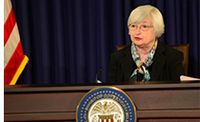The FRBNY DSGE Model Forecast—February 2017
This post presents the latest update of the economic forecasts generated by the Federal Reserve Bank of New York’s (FRBNY) dynamic stochastic general equilibrium (DSGE) model. We introduced this model in a series of blog posts in September 2014 and published forecasts twice a year thereafter. With this post, we move to a quarterly release schedule, and highlight how our forecasts have changed since November 2016.
Readers should keep in mind that the DSGE model forecast is not an official New York Fed forecast, but only an input to the Research staff’s overall forecasting process. For more information about the model and the variables discussed here, see our DSGE Model Q & A.
The FRBNY DSGE Model Forecast—November 2016
This post presents the latest update of the economic forecasts generated by the Federal Reserve Bank of New York’s (FRBNY) dynamic stochastic general equilibrium (DSGE) model.
What Drives Forecaster Disagreement about Monetary Policy?

What can disagreement teach us about how private forecasters perceive the conduct of monetary policy? In a previous post, we showed that private forecasters disagree about both the short-term and the long-term evolution of key macroeconomic variables but that the shape of this disagreement differs across time. In contrast to their views on other macroeconomic variables, private forecasters disagree substantially about the level of the federal funds rate that will prevail in the medium to long term but very little on the rate at shorter horizons. In this post, we explore the possible explanations for what drives forecasts of the federal funds rate, especially in the longer run.
Restoring Economic Growth in Puerto Rico: Introduction to the Series
The difficult economic and financial issues facing the Commonwealth of Puerto Rico have remained very much in the news since our post on options for addressing its fiscal problems appeared last fall. That post was itself a follow-up on a series of analyses, starting with a 2012 report that detailed the economic challenges facing the Commonwealth. In 2014, we extended that analysis with an update where we focused more closely on the fiscal challenges facing the Island. As the problems deepened, we have continued to examine important related subjects ranging from positive revisions in employment data, to the understanding emigration, and to considering how the Commonwealth’s public debts stack up. In most of this work, we have focused on how policymakers could help to address the immediate issues facing the Island and its people. The U.S. Congress and the Obama Administration took action in June to provide a framework to help address Puerto Rico’s fiscal crisis. But much remains to be done to address these ongoing problems, which represent a significant impediment to economic growth in the short run. It also seems important to revisit the question of the prospects for reviving longer-run growth in the Commonwealth. These concerns were underscored by projections published by the International Monetary Fund (IMF) in the April edition of the World Economic Outlook that forecast Puerto Rico’s real GDP and population to decline through 2021.
The FRBNY DSGE Model Forecast—May 2016
The May 2016 forecast of the Federal Reserve Bank of New York’s (FRBNY) dynamic stochastic general equilibrium (DSGE) model remains broadly in line with those of our two previous semiannual reports (see our May 2015 and December 2015 posts). In the past year, the headwinds that contributed to slower growth in the aftermath of the financial crisis finally began to abate. However, the widening of credit spreads associated with swings in financial markets in the second half of 2015 and the first few months of this year have had a negative impact on economic activity. Despite this setback, the model expects a rebound in growth in the second half of the year, so that the medium-term forecast remains, as in the December post, one of steady, gradual economic expansion. The model also continues to predict gradual progress in the inflation rate toward the Federal Open Market Committee’s (FOMC) long-run target of 2 percent.
Just Released: Introducing the New York Fed Staff Nowcast

What is the weather today? You don’t need to be a meteorologist to answer this question. Just take a look outside the window. Macroeconomists do not have this luxury. The first official estimate of GDP this quarter will not be published until the end of July. In fact, we don’t even know what GDP was last quarter yet! But while we wait for these crucial data, we float in a sea of information on all aspects of the economy: employment, production, sales, inventories, you name it. . . . Processing this information to figure out if it is rainy or sunny out there in the economy is the bread and butter of economists on trading desks, at central banks, and in the media. Thankfully, recent advances in computational and statistical methods have led to the development of automated real-time solutions to this challenging big data problem, with an approach commonly referred to as nowcasting. This post describes how we apply these techniques here at the New York Fed to produce the FRBNY Nowcast, and what we can learn from it. It also serves as an introduction to our Nowcasting Report, which we will update weekly on our website starting this Friday, April 15.
What Tracks Commodity Prices?

Various news reports have asserted that the slowdown in China was a key factor driving down commodity prices in 2015. It is true that China’s growth eased last year and, owing to its manufacturing-intensive economy, that slackening could reasonably have had repercussions for commodity prices. Still, growth in Japan and Europe accelerated in 2015, with the net result that global growth was fairly steady last year, casting doubt on the China slowdown explanation. An alternative story relies on the strong correlation between the dollar and commodity prices over time. A simple regression shows that both global growth and the dollar track commodity prices, and in this framework, it is the rise of the dollar that captures last year’s drop in commodity prices. Thus a forecast of stable global growth and an unchanged dollar suggests little change in commodity prices in 2016.
From the Vault: The Path of Interest Rates
Fundamental Disagreement: How Much and Why?
Richard K. Crump and Stefano Eusepi Everyone disagrees, even professional forecasters, especially about big economic questions. Has potential output growth changed since the financial crisis? Are we bound for a period of “secular stagnation”? Will the European economy rebound? When is inflation getting back to mandate-consistent level? In this post, we document to what degree […]












 RSS Feed
RSS Feed Follow Liberty Street Economics
Follow Liberty Street Economics